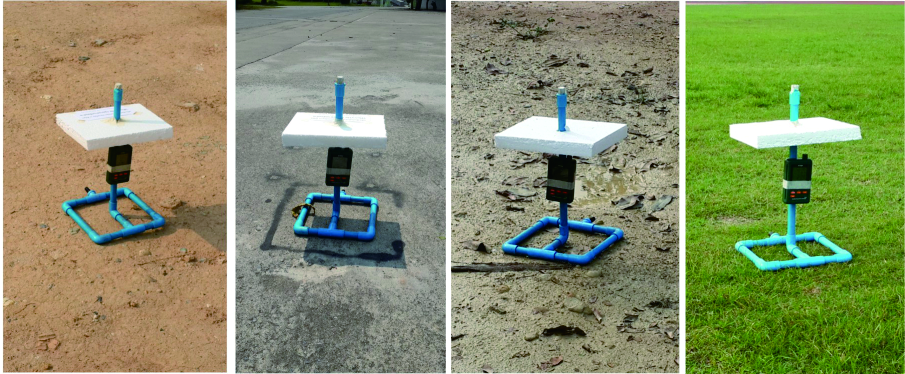The Impact of Site Elements to Micro-Climate Air Temperature
Main Article Content
Abstract
Global warming effect has been a serious issue for decades. The impact of site element is one of influ-ence factors in architectural design and energy conservation. This study focused on material heat capacity properties of wet grass (0.7 Btu/oF), wet-soil (0.6 Btu/oF), concrete (0.23 Btu/ oF) and dry-soil (0.19 Btu/oF) surfaces. Outdoor air temperature was influenced by those selected materials. Air temperature data were collected for 24 hours. During daytime, those surfaces received heat from solar radiation in a range of 240 to 260 Btu/ft2/h It is found that outside air temperature among wet-grass surface had raised 0.9oC similar to wet-soil as 1.8oC while concrete 2.6oC and dry-soil 2.9oC. This illustrates that high heat capacity outdoor surfaces have less effected to raise air temperature than the others. Shades can reduce air temperature cov-ered dry-soil and concrete ground by 3.7oC and 4.9oC, respectively. Therefore, it can be concluded that to reduce outdoor air temperature, those materials should have high heat capacity property and shade from vegetation can shield materials with low heat capacity. It has less effect outdoor air temperature raise which cause energy conservation in building.
Downloads
Article Details

This work is licensed under a Creative Commons Attribution-NonCommercial-NoDerivatives 4.0 International License.
All material is licensed under the terms of the Creative Commons Attribution 4.0 International (CC-BY-NC-ND 4.0) License, unless otherwise stated. As such, authors are free to share, copy, and redistribute the material in any medium or format. The authors must give appropriate credit, provide a link to the license, and indicate if changes were made. The authors may do so in any reasonable manner, but not in any way that suggests the licensor endorses you or your use. The authors may not use the material for commercial purposes. If the authors remix, transform, or build upon the material, they may not distribute the modified material, unless permission is obtained from JARS. Final, accepted versions of the paper may be posted on third party repositories, provided appropriate acknowledgement to the original source is clearly noted.
References
ASHRAE Standard 90.1 (2007). Energy standard for buildings except low-rise residential buildings (I-P edition). Atlanta: ASHRAE.
Bowring, J. (1969). The Kingdom and people of Siam. London: Oxford University Press, UK.
Chitranukroh, J. (2007). The analysis of essential factors in traditional Thai house technology: central Thailand. Doctor of Philosophy, Architecture, Chulalongkorn University, Bangkok, Thailand.
Energy Development and Efficiency. (2013). Facts & figures: energy in Thailand Q1/2013. Department of Alternative. Bangkok, Thailand.
Geiger, R. (1950). The climate near the ground. Cambridge: Harvard University, USA.
Iamtrakul, P., Nusook, T. & Ubolchay, P. (2014). Impact of urban heat island on daily life of people in Bangkok metropolitan region (BMR). Journal of Architectural/Planning Research and Studies, 11(2), 53-72.
Kongboontiam, P. & Puraprom, W. (2015). Guidelines for reducing air temperature using effects of ground cover. Journal of the Faculty of Architecture, Silpakorn University, 29, 321-334.
Stein, B. & Reynolds, J. S. (2000). Mechanical and electrical equipment for buildings. 9thed. New York: John Wiley & Sons.
Boonyatikarn, S. (1982). A method for developing energy budgets and energy design guidelines for institutional buildings. Doctoral Dissertation of Architecture, University of Michigan, USA.
Fanger, O. P. (1970). Thermal comfort. New York: McGraw-Hill.
Hansen, J. et al. (2006). The reason global warming is manmade. The NASA’s Goddard Institute for Space Studies.
Meteorological, D. (2015). Yearly weather summary: Thailand annual weather summary, Bangkok.
Nusantara, G. (2011). Why is it hotter in Jakarta? The urban heat island effect in Indonesia. Kapi’olani Community College in Honolulu. Indonesia.
Olgyay, V. (1992). Design with climate: bioclimatic approach to architectural regionalism. New York: Van Nostrand Reinhold.
Saiyavath, P. & Haocharoen, K. (2009). Development of downtown open space to mitigate urban heat island effect: A case study of Silom road, Bangkok. Journal of Architectural/Planning Research and Studies, 6(2), 35-44.
Skelhorn, C. (2012). The impact of vegetation types on air and surface temperatures in a temperature city: A fine scale assessment in Manchester, UK. Manchester: University of Manchester.
Srivanit, M. & Auttarat, S. (2015). The summer thermal environment and human comfort of shaded outdoor and semi-outdoor spaces to living in the urban area of Chiang mai city. Journal of Architectural/Planning Research and Studies, 12(2), 53-72.


